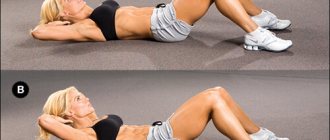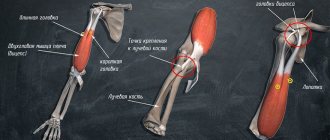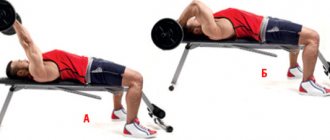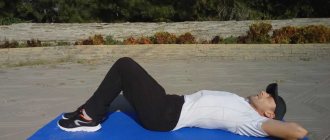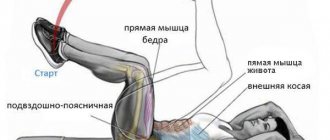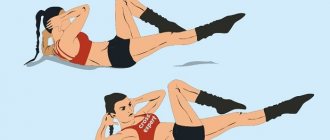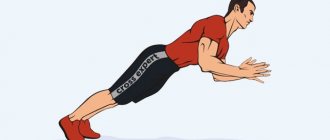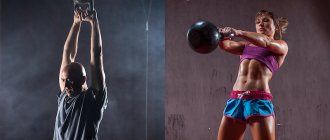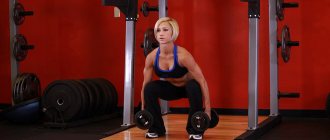Anyone who plays sports probably has the goal of getting beautiful, sculpted abs. Some people just want to tighten their belly, while others want to pump up noticeable abs. An exercise such as abdominal crunches, which is considered one of the main ones for the abdominal muscles, helps with these goals. Despite the fact that the exercise is quite simple, the correct technique for performing it is very important, so it is recommended that you familiarize yourself with all the nuances.
What does training give?
So, let's look at the “twisting” exercise for the press with a photo. It is an excellent abdominal workout. It ranks third in popularity among newcomers. With the correct execution of the exercise, you can both pump up large cubes and simply tighten your stomach. In terms of difficulty level, twisting exercises occupy a middle position. They are perfect for both beginners and professionals.
There are different types of crunches, each of which works a specific area of the abs. By choosing the right option, you can perform the exercise purposefully. We’ll describe how to do abdominal crunches correctly in various variations below, but now we’ll talk in more detail about which muscles are used when performing them.
Additional materials
- Abdominal muscle training
- How to pump up your abs
- Ab exercises
- Abdominal exercises for girls
- How to pump up abs on your stomach
- Abdominal stabilizing muscle training
- Crunches
- Side crunches
- Two-phase twisting
- Diagonal twist
- Double twist
- Combined twist
- Reverse crunch on the ball
- Incline crunch with body raise
- Twisting with body rotation
Advantages and Benefits
By performing the crunch exercise, you bring great benefits to your body. Using different types of training, you can make the process more varied, and also work on certain parts of the abdominal muscles in isolation.
If you perform the exercise correctly, your posture will straighten, your spine will become more flexible, and its general condition will improve.
During exercise, blood flow increases, which delivers beneficial nutrients to the spinal discs. Such exercises strengthen the tissues and prepare them for heavy loads. As a result, the risk of future injury is significantly reduced.
In addition, blood flow to internal organs improves, the functioning of the digestive system is stabilized, and memory improves. Also, a strong abs keeps the spine healthy, because the stronger the muscle corset, the less stress the skeleton receives.
One of the significant advantages is that the “twisting” exercise can be performed at home, since its technique is relatively simple and does not require additional equipment.
What muscles are trained?
Regardless of the various variations of the side twist, the main areas worked are the transverse and oblique abdominal muscles. Also during training, the arms, hips, and shoulder joints work, but the participation of these areas of muscle mass is insignificant.
Side crunches have a positive effect on the spine, but only if you have a healthy back. If you have vertebral pathologies, do not perform the exercise without the advice of a specialist.
Execution technique
Let's look at the different types of training. The classic version is called “straight twists”. The exercise is performed according to the following scheme:
- Take the starting position. To do this, lie on the floor, bend your knees, place your feet firmly on the floor, and place your hands behind your head.
- As you exhale, smoothly, without sudden movements, lift the upper part of the body (the position of the lower back and buttocks remains the same: they should be pressed tightly to the floor). The back should be slightly rounded.
- Also, without sudden movements, turn to the side until you feel maximum tension. Stay in this position for a few seconds.
- After this, begin returning to the starting position. Do it slowly and smoothly.
- Repeat on the other side.
Exercise options
There are endless variations on this exercise. We have already considered two. You can leave your knees bent on the floor and reach your elbow towards the opposite knee. Or you can extend your working arm and reach your palm towards the foot of the same side.
- “Bicycle” is another exercise for oblique twists, in which the direction of the sides alternates.
- To enhance the effect, you can perform oblique crunches on an incline bench. The execution technique will be the same, but the effectiveness due to the resistance force will be higher.
We looked at performing oblique crunches from a lying position. The element is also effective from other positions: sitting and standing. How to do oblique twists in this case? Very simple!
- Side crunches from a standing position. The focus here is on the slopes. We stand up straight, place our hands behind our heads like a butterfly and bend our body in different directions. Another variation is to slide straight arms along the body or to the opposite leg.
- Oblique twists from a sitting position. We sit down on a chair, our hands also take the butterfly position. As you exhale, turn your body to the side.
Tips for performing classic crunches
They look like this:
- Try not to press your chin to your chest; there should be a small distance between them.
- When performing the exercise, you do not need to bend your entire torso. Only the back should be rounded.
- Feet should be pressed to the floor. Directly when twisting, try not to tear them off the surface.
- It is important to stay in this position for a few seconds. You should lower while inhaling.
- The abdominal muscles should remain tense throughout the entire exercise.
- The classic crunch, performed both at home and in the gym, can be done at the beginning or end of a workout.
- If you're just starting to learn a new exercise, start with three sets of 10-12 repetitions. After your body gets used to the load, you can increase the number of approaches to five, 15-20 times.
Remember how to do the crunch exercise - it is not the number of repetitions that is important, but the quality of execution. The effectiveness of the work done is only possible if the exercise is performed conscientiously.
Inclusion in the program
The exercise can be included in at least every strength training session, especially if you do them no more than 3-4 times a week. The more often this movement appears in the program, the more likely it is that oblique hypertrophy will be achieved. For those for whom this is not a priority, it is enough to train the obliques once a week.
Usually, the oblique muscles are trained after the straight muscles and strictly at the end of the training complex.
The number of repetitions is determined individually, depending on the athlete’s form, and the number of approaches can be from 2 to 4.
If an athlete performs strength training regularly and with great dedication, and includes basic exercises in his training, he should refuse to train this movement immediately after a deadlift or squat. Typically, such athletes are recommended to perform this exercise at the beginning, as part of a warm-up, in a small volume.
The exercise may not be included in the program if the obliques are normally developed and no additional effort is required.
Those who do not want to increase the size of their waist are recommended to perform the exercise statically, and simply remain in the side plank or T-pose, and not do twisting.
The weight of the weights should be carried in your free hand, and it is recommended to use no more than a third of your body weight, even if you are an experienced athlete. Athletes must balance their efforts with the fitness they have.
Reverse crunches
Let's describe the training technique. To perform the reverse ab crunch exercise, lie on the floor or, alternatively, on a bench. Bend your legs at the knees and raise them. Your shins should be parallel to the floor, and your thighs should be perpendicular. Place your hands behind your head. Pull your knees towards your chest. The abdominal muscles are tense. At the peak of maximum load, the pelvis should be raised above the floor. Hold this position for a few seconds, then slowly lower your legs.
Lateral (oblique) twists
Having already read the second name of this type of exercise, you understand that it is aimed at working the oblique muscles.
The algorithm for performing lateral twists is as follows:
- lie on the floor, bend your legs and turn to the left;
- we place our right hand behind our head, place our left hand on our stomach closer to the right side;
- as you exhale, straining your right oblique muscles, try to reach the same knee with the corresponding elbow;
- as in previous options, this position must be fixed for a few seconds and only then returned to the starting position.
Now, turning your legs to the right and mirroring the actions described above, work the same way on the left side.
Diagonal crunches
This type of twist is in many ways similar to the classic version, but it has its own characteristics. The exercise is performed as follows:
- lie on the floor so that your lower back is in contact with the surface;
- bend your knees to a right angle;
- we place our right hand behind our head, and place our left hand on the floor along the body;
- the next thing to do is lift your shoulder off the floor and try to touch your right elbow to your left knee;
- After the movement is completed, return to the starting position.
Switching hands, do the same exercise for the other side.
Contraindications
At first glance, this movement looks harmless, but it should not be performed if you have any problems with the spine. It can lead to displacement of the vertebrae. Those who have hernias and protrusions should refuse the exercise.
Those who have rectus diastasis after pregnancy should also avoid performing this exercise. You should activate your core in other ways, such as doing planks.
Double crunches
If when performing classic exercises only the rectus abdominis muscles are used, then this variation assumes an even distribution of the load throughout the entire abs. With double crunches, you will work both the lower and upper parts of the muscle well.
The training is performed according to the following scheme:
- you need to lie on your back on the floor, your lower back should be pressed against the floor surface;
- bend your knees to a right angle, also press your feet tightly to the floor;
- we place our hands behind our heads, not forgetting that we cannot close them;
- To avoid damage, remember to breathe;
- We begin to perform the exercise while exhaling: we pull the chest and pelvis towards each other. We hold this position for a few seconds and lower ourselves while inhaling.
Analysis of the exercise
What muscles work
This is an abdominal shaping exercise that can make your obliques more defined and your waistline more defined. But we are only talking about people with a minimum percentage of fat. For everyone else, doing this exercise will simply help you tone up and create a thinner waist by getting rid of sagging muscles.
Participating in the work:
- Obliques as main engines;
- Anterior serratus;
- Intercostal;
- Rectus abdominis muscle
Preparation
You can prepare for the exercise by doing a normal warm-up. For example, you must first perform a cardio warm-up on a treadmill or elliptical trainer, and then do a series of inclines.
Then you should rule out injuries due to the mat sliding, and if necessary, wear long sleeves to avoid slipping and injuries to your forearms.
Proper execution
- Full concentration on twisting is achieved through breathing. You should take a deep breath and exhale just during the effort, during the twisting phase;
- You don’t need to clasp your hands together and press them on the back of your head, this is the only way you will work safely for your neck;
- The back is pressed to the floor as much as possible. If we are talking about the position of lying on the side, then the side. You should avoid movements by “throwing” your head with your hands,
- It is not recommended to put pressure on the back of the head with your hands and involve the neck in the movement. The old rule that the chin should be approximately one orange away from the chest still applies;
bodymaster : Oblique crunches on the floor
Errors
- Neck nods;
- Adding weights that do not help improve technique and the situation as a whole;
- Flexion at the hip joint and no tension in the target muscle, that is, no twisting;
- Holding your breath
Efficiency Tips
- The main thing is not to strain your neck, and not to switch attention from working with the core muscles to the chin, neck and cervical region;
- You should not completely relax your muscles if you do not have enough load. Use a technique that does not completely relax the abdominal muscle and does not place the shoulder on the floor;
- Weights can be used for those who really need hypertrophy of the oblique muscles. For everyone else, it makes sense to do without a dumbbell in your hands - the waist will already take on a more toned shape
Crunches on a fitball
Let's consider training on a machine. Performing the “twisting” abdominal exercise using a fitball is suitable for trained people. Beginners should hold off on this variety.
The exercise is performed like this:
- sit on the fitball and spread your legs to the sides;
- go down a little, your back should be on the ball;
- we put our hands behind our heads;
- as you exhale, perform twisting, lifting your torso up;
- do not forget that you need to stay in this position for a few seconds, the abdominal muscles are always tense;
- return to the starting position.
Content
- 1 Standard straight twist
- 2 Straight dumbbell curl
- 3 Raising the body from a lying position with bent knees
- 4 Incline crunches
- 5 Additional materials
Straight body crunches are a necessary element for high-quality pumping of the abdominal muscles. Although, while performing different variations of this exercise, other muscle groups also work. To achieve the best effect, with sufficient training experience and appropriate preparation, weights are used when performing straight crunches. However, twisting exercises themselves are quite effective.
Standard straight crunches
There are so many variations in performing this category of exercises. These include:
- standard straight twist;
- dumbbell curls;
- lifting the body from a lying position with legs bent at the knees;
- crunch on an incline bench.
Let's talk about each of the listed variations in more detail.
Standard straight twist
The main muscles involved in this group of exercises are: the lower half of the abdominal press, the oblique abdominal muscle. Additional muscles that take part in the process include the muscles of the shoulder girdle and the upper abdominals.
A little trick when performing crunches is to change the pace when performing the actions. Thus, a greater effect can be achieved if you quickly raise your body, fixate for a few seconds at the top point of the twist, and then slowly lower your body to its original position. This style of execution increases the time during which the greatest load is placed on the target muscles and relatively unloads additional groups.
Direct execution will look like this. Starting position: the athlete lies on a bench with his legs bent at the knee joint. Then, tensing your abdominal muscles, you need to raise your head up and point your shoulders forward. Fix at the maximum point and smoothly lower.
Straight crunches with dumbbells
Straight dumbbell curl
The upper and lower abdominal groups are involved as the main muscles in this case. The muscles of the thighs, buttocks and lower back are used as additional groups.
Starting position when performing: the athlete lies on the floor (a gymnastic mat is used), with his arms and legs extended upward. The dumbbell must be held by one side so that the center of gravity is vertical.
After taking the starting position, you need to exhale and quickly simultaneously lift your buttocks, as well as your head and shoulders, from the floor in an upward direction. The arms and legs move in two directions: up and towards each other. The athlete then slowly returns to the starting position.
Straight crunches with bent knees
Raising the body from a lying position with bent knees
The main muscles of this twist variant are the upper and lower abdominals. The thigh muscles are used as additional muscles. Important: the feet must be fixed when performing the exercise.
Starting position: the athlete lies on his back, with his knees bent and his arms straight but raised, his head also raised above the floor. When performing the exercise, you need to pull your chest towards your knees and fixate at this point for a few seconds. Return to starting position slowly.
Straight crunches on an incline bench
Incline crunches
The main muscles working in this variation are the rectus abdominis group, the additional muscles are the external obliques and the thigh muscles. Starting position: lie on an inclined bench with your head down, place your feet behind the bolsters, bend your knees slightly, clasp your hands behind your head. Working with the rectus abdominis muscles, you need to raise the body to a vertical position, fix it at the top point and slowly lower to the starting position.
Performing twists in each of the variations is performed in 3-5 approaches of 10-15 times, depending on the level of training.
Russian crunches
This type of exercise will be effective for working the oblique abdominal muscles. How to do crunches in Russian correctly? To perform the exercise, sit on the floor, bend your knees and lean back slightly. Lifting your feet off the floor, alternately turn your body in one direction or the other. At the same time, the legs should remain motionless.
Ab crunches: features and benefits
The ab crunch exercise is similar to, but different from, regular sit-ups. The amplitude is not so important here, and it is not at all necessary to raise the body to a right angle. Continuous muscle activity is more important, as is movement control. To do this, you can slightly round your back in the thoracic region. This is completely acceptable and does not increase the risk of injury.
The good thing about crunching exercises is that by choosing one type or another, you can diversify your workout and target a specific area of the abs. They also have a beneficial effect on the condition of the spine and posture.
The exercise itself is quite simple. While performing it, you will feel the stretching and contraction of the abs, which indicates the effectiveness of twisting. You can do them anywhere and anytime, without using simulators or additional equipment. By devoting just 10-15 minutes , you can fully work out your abdominal muscles. It is only important to know how to do crunches correctly.
